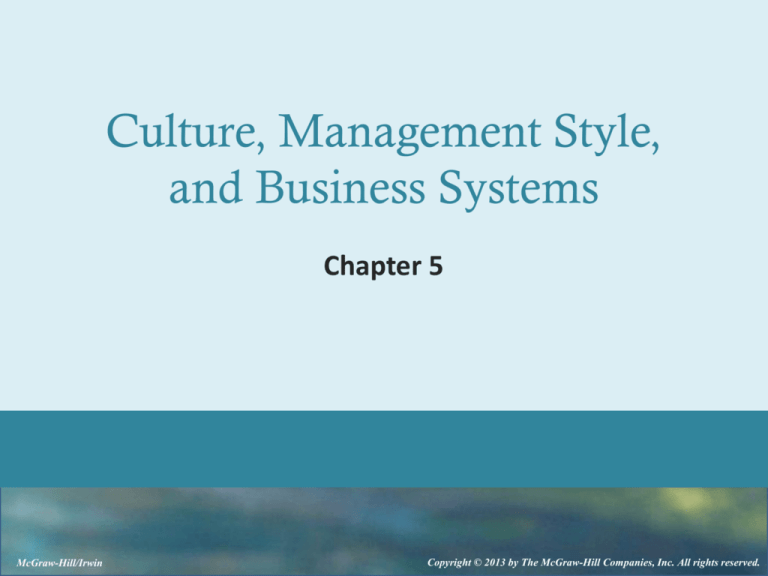
Culture, Management Style,
and Business Systems
Chapter 5
McGraw-Hill/Irwin
Copyright © 2013 by The McGraw-Hill Companies, Inc. All rights reserved.
Learning Objectives
LO1 The necessity for adapting to cultural differences
LO2 How and why management styles vary around
the world
LO3 The extent and implications of gender bias in
other countries
LO4 The importance of cultural differences in
business ethics
LO5 The differences between relationship-oriented
and information-oriented cultures
5-2
Business Customs in Global Marketing
Business etiquette is largely driven by
cultural norms.
Cultural analysis often pinpoints
market opportunities, gives companies
a competitive edge
5-3
Requires Adaptation
Adaptation is a key concept in international marketing
To successfully deal with individuals, firms, or authorities
in foreign countries, managers should exhibit:
•
•
•
•
•
•
•
•
•
•
open tolerance,
flexibility,
humility,
justice/fairness,
ability to adjust to varying tempos,
curiosity/interest,
knowledge of the country,
liking for others,
ability to command respect, and
ability to integrate oneself into the environment
5-4
Cultural Imperatives, Electives
and Exclusives
Cultural imperatives:
• business customs and expectations that must
be met, conformed, recognized and
accommodated if relationships are to be
successful
Cultural electives:
• areas of behavior or to customs that cultural
aliens may wish to conform to or participate in
but that are not required
5-5
BEIJING, CHINA: German Chancellor Angela Merkel and Chinese Prime Minister Wen Jiabao
toast after the EU–China Business Summit at the Great Hall of the People in Beijing. The
summit was boosted by the settlement of a trade row that had left 80 million Chinese-made
garments piled up in European seaports, unable to be delivered to shops under a quota pact
agreed to at the time. Drinking half a bottle is a cultural elective, but taking a sip is more of
an imperative in this case.
5-6
Cultural Imperatives, Electives
and Exclusives
Cultural exclusives:
• customs or behavior patterns reserved exclusively for the
locals and from which the foreigner is barred and must not
participate
5-7
The Impact of American Culture
Ways in which U.S. culture has influenced
management style include, but are not limited to, the
following:
1.
2.
3.
4.
5.
Personnel selection and reward based on merit
Decisions based on objective analysis
Wide sharing in decision making
Never-ending quest for improvement
Competition yielding efficiency
5-8
American Culture and
Management Style
There are at least three reasons to focus briefly on
American culture and management style:
1. for Americans, it is important to be aware of the
elements of culture influencing decisions and behaviors.
2. for those new to American culture, it is useful to better
understand business associates from the States as the
U.S. market is the biggest export market in the world
3. since the late 1990s, American business culture has been
exported around the world
5-9
Differences in Management Styles
Around the World
Authority and Decision Making
• In high-PDI countries subordinates are not likely to contradict
bosses, but in low-PDI countries they often do
• Three typical patterns exist:
1.
2.
3.
top-level management decisions,
decentralized decisions, and
committee or group decisions
Management Objectives and Aspirations
•
•
•
•
Security and Mobility
Personal Life
Affiliation and Social Acceptance
Power and Achievement
5-10
Insert Exhibit 5.1
Annual Hours Worked
Source: OECD, Labor Market Indicators, 2012.
5-11
Differences in Management Styles
Around the World
Differences in Communication Styles
• Face to Face Communication
• Internet Communication
According to Edward T. Hall, the symbolic meanings of time,
space, things, friendships, and agreements, vary across
cultures
Hall places eleven cultures along a high-context/low-context
continuum
Communication in a high-context culture depends heavily on
the contextual (who says it, when it is said, how it is said) or
nonverbal aspects of communication
Communication in a low-context culture depends more on
explicit, verbally expressed communications
5-12
5-13
5-14
Differences in Management Styles
Around the World
Formality and Tempo
• Level of formality in addressing business clients by first
name
• Level of formality in addressing your boss by first name
• Tempo or speed in getting “down to business”
• Perception of time varies in many cultures
5-15
Differences in Management Styles
Around the World
P-Time versus M-Time
• M-time, or monochronic time, typifies most North
Americans, Swiss, Germans, and Scandinavians
• Most low-context cultures operate on M-time
concentrating on one thing at a time
• P-time, or polychronic time, is more dominant in highcontext cultures
• P-time is characterized by multi-tasking and by “a great
involvement with people”
5-16
5-17
Differences in Management Styles
Around the World
Negotiations Emphasis
• Differences with respect to the product, its price and
terms, services associated with the product, and finally,
friendship between vendors and customers
Market Orientation
• American companies are embracing the market orientation
philosophy
• Other countries are still in the traditional production,
product and selling orientations
5-18
Gender Bias in International Business
The gender bias against women
managers exists in some countries
• Women are not easily accepted in upper
level management roles in Asia, Middle
East, and Latin America (although this is
changing)
Gender bias poses significant challenges
in cross-cultural negotiations
5-19
5-20
5-21
Business Ethics
Business ethics is complex in the international
marketplace because value judgments differ widely
among culturally diverse groups
Corruption varyingly defined from culture to culture
5-22
Business Ethics
Existence of different levels of corruption, bribery,
and fraud
• The Foreign Corrupt Practices Act 1977: Imprisonment for
bribery
Bribery creates a major conflict between ethics and
profitability
5-23
Transparency International
Transparency International - USA
5-24
5-25
Bribery: Variations on a Theme
Bribery
• Voluntarily offered payment by someone
seeking unlawful advantage
Extortion
• Payments are extracted under duress by
someone in authority from a person seeking
only what they are lawfully entitled
5-26
Bribery:
Variations on a Theme
Lubrication
• Involves a relatively small sum of cash, a gift, or a service
given to a low-ranking official in a country where such
offerings are not prohibited by law
Subornation
• Involves giving large sums of money—frequently not
properly accounted for—designed to entice an official to
commit an illegal act on behalf of the one offering the
bribe; involves breaking the law
5-27
A Framework for Ethical Principles
(1)
Utilitarian
ethics
Does the action optimize the
“common good” or benefits of all
constituencies? And, who are the
pertinent constituencies?
(2) Rights of
the parties
Does the action respect the rights of
the individuals involved?
(3) Justice or
fairness
Does the action respect the canons of
justice or fairness to all parties
involved?
5-28
5-29






